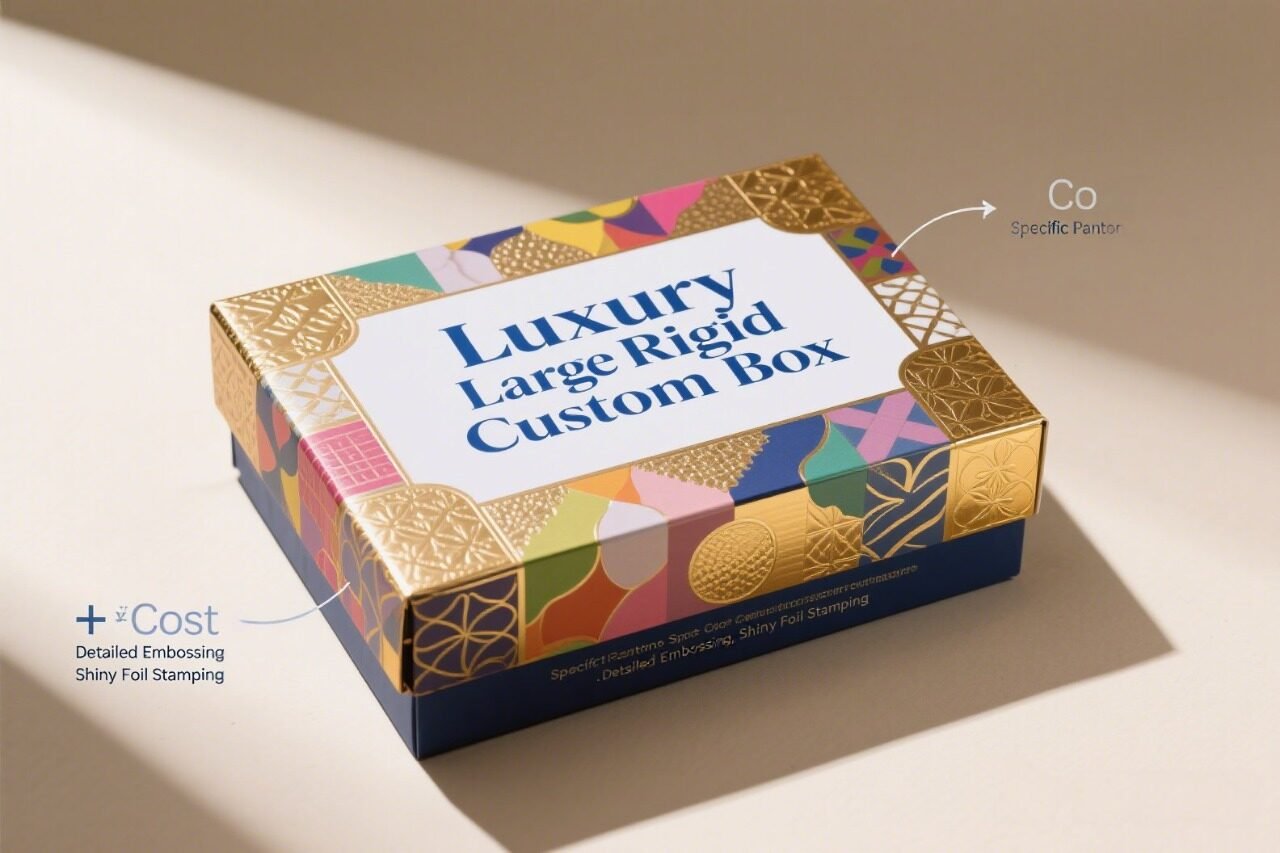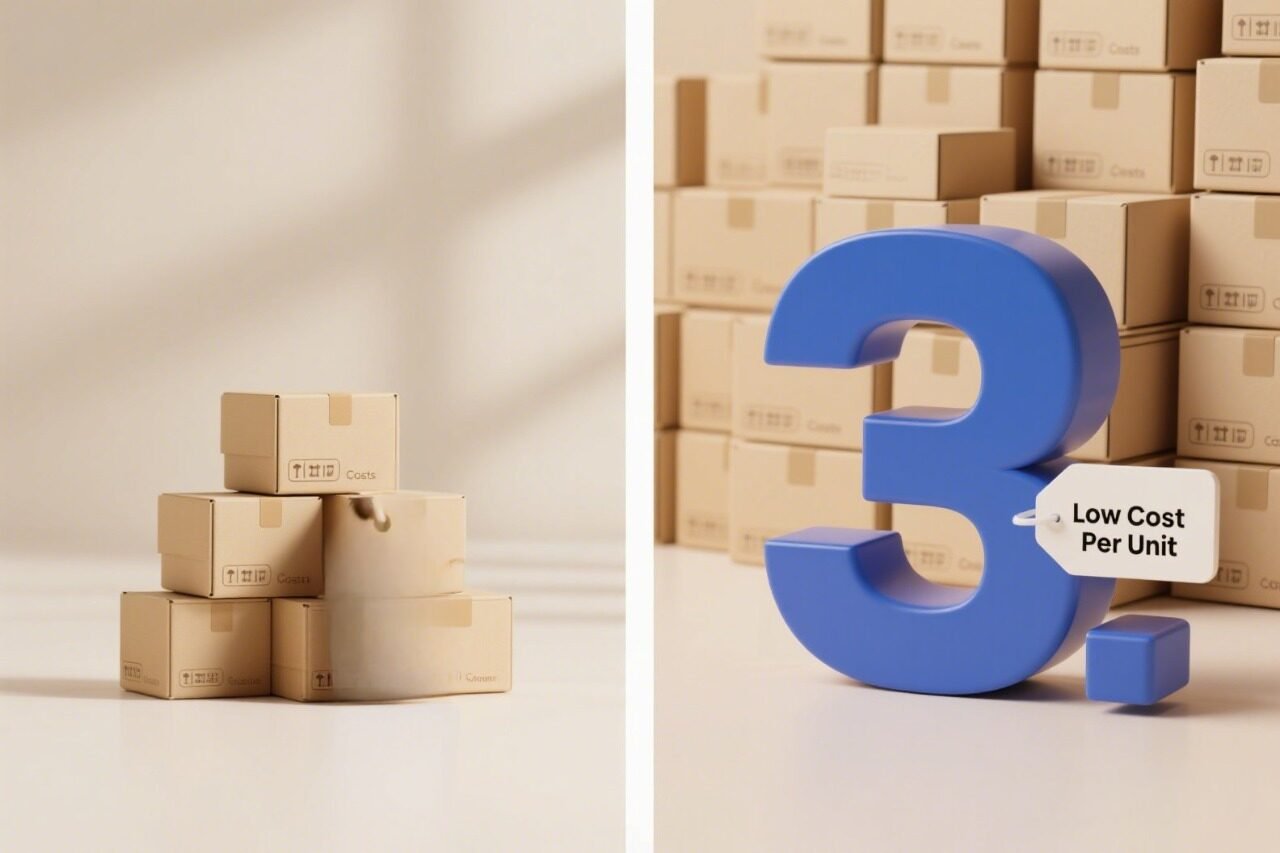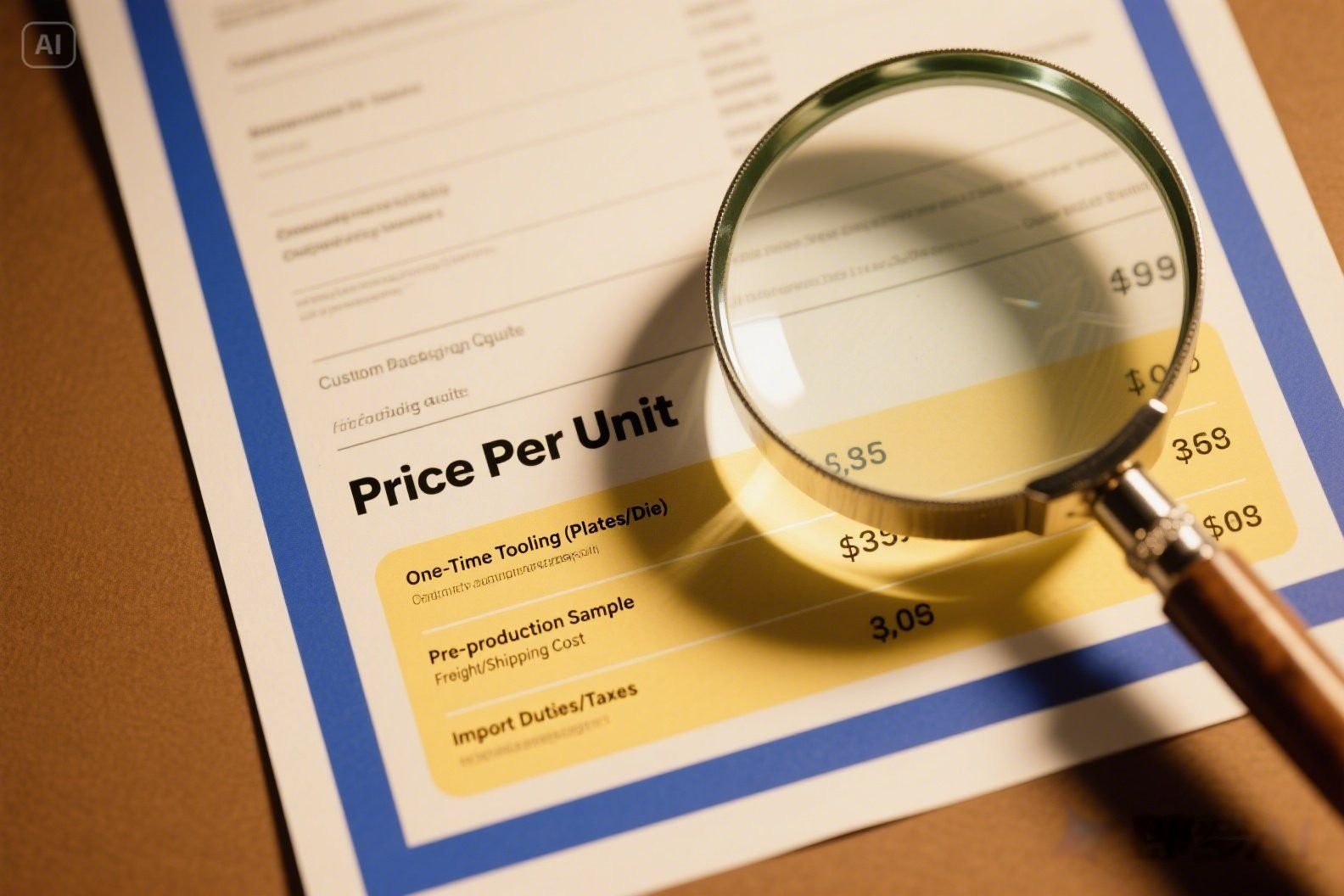Trying to budget for custom packaging feels confusing, right? Prices seem all over the place. Unexpected costs can eat into your profits and cause major headaches.
There's no single price tag for custom packaging. Costs depend heavily on size, material choice, order quantity, printing complexity, and special finishes. Simple, small boxes in large quantities cost less per unit than large, complex boxes with fancy finishes ordered in small quantities.
Understanding the specific factors that influence the final price is key to getting a realistic quote and managing your budget effectively. Let's break down the main cost drivers you need to know.
What Are the Biggest Factors Driving Up Costs?
Why did that packaging quote seem higher than you expected? Hidden costs are frustrating. Let's pinpoint the main factors that add dollars to your custom packaging order.
The biggest cost drivers are typically complex structures1 (like rigid boxes), low order quantities (below optimal levels), large physical size, premium materials, multi-color printing with special Pantone inks, and elaborate finishes like foil stamping or embossing.

When we prepare quotes for clients at Finer-Packaging, these elements consistently have the biggest impact on the final price per piece. Understanding them helps you make informed decisions about your design and budget.
Size & Material Weight
It's simple physics: bigger boxes use more material.
- Surface Area: The larger the length, width, and height of your box, the more paperboard or plastic sheeting is needed. This directly increases the raw material cost.
- Material Thickness/Weight: Using thicker or heavier paperboard (measured in GSM2 - grams per square meter, or caliper points) provides more rigidity and a premium feel, but also uses more raw material fibre and costs more. We help you select a weight that provides necessary protection without unnecessary expense.
- Shipping Impact: Larger and heavier packaging also increases shipping costs, both from our factory in China to you and potentially from you to your end customer.
Material Type & Structure
The type of packaging and how it's constructed significantly affects cost, mainly due to material differences and labor involved.
- Folding Cartons: Generally the most cost-effective for custom boxes. Made from single-layer paperboard (like CCNB or SBS), printed flat, die-cut, and glued. Relatively efficient production.
- Corrugated Boxes: Made from fluted paper3 sandwiched between linerboard (like E-flute or B-flute). Offers more protection than folding cartons. Cost is typically higher due to more complex material structure but still efficient for mailers or product boxes needing strength.
- Rigid Boxes (Set-up Boxes): The most premium and expensive option. Made from thick chipboard wrapped with printed paper. Requires significant hand labor for assembly, wrapping, and finishing. Often used for luxury goods, electronics, or gift sets.
| Box Type | Typical Material | Complexity | Relative Cost Level | Example Use |
|---|---|---|---|---|
| Folding Carton | Paperboard (SBS/CCNB) | Low | $ | Cereal box, cosmetic box |
| Corrugated Box | Corrugated Board | Medium | $$ | Mailer box, subscription box |
| Rigid Box | Chipboard + Wrap Paper | High | $$$ | iPhone box, gift box |
Order Quantity (MOQ Matters!)
This is one of the most significant factors. We'll discuss it more later, but essentially:
- Setup Costs:4 Setting up printing presses, cutting dies, and gluing machines involves fixed costs and time.
- Economies of Scale: Spreading these fixed setup costs over a larger number of units drastically reduces the cost per individual box.
- MOQ: Manufacturers like us have Minimum Order Quantities (MOQs) – typically 500 pieces for most paper boxes at Finer-Packaging, with 1000+ often being more cost-effective. Ordering below MOQ is often not feasible or prohibitively expensive per unit.
How you print your design impacts cost.
- Number of Colors: CMYK (4-color process) is standard for photos and complex graphics. Adding specific Pantone (PMS) spot colors5 for perfect brand color matching requires extra printing plates and setup for each spot color, increasing cost. A simple 1 or 2-color Pantone job might sometimes be cheaper than CMYK if no complex images are involved, but adding Pantones to CMYK always adds cost.
- Ink Coverage: Very heavy ink coverage across large areas might slightly increase ink consumption cost, but the number of plates/colors is usually a bigger factor.
Special finishes make packaging look premium but add processes and cost.
- Lamination (Gloss/Matte): Adds a protective film and enhances appearance. Relatively standard and cost-effective.
- Varnish (Spot/Flood): A liquid coating for protection or visual effect (like spot UV, making one area glossy on a matte background). Spot UV adds a noticeable cost.
- Foil Stamping: Applying metallic or colored foil to specific areas. Requires a custom stamping die and extra machine pass. Adds significant cost.
- Embossing/Debossing: Raising or depressing parts of the design. Requires custom dies and an extra machine pass. Adds significant cost.
| Finish | Typical Cost Impact | Purpose |
|---|---|---|
| Gloss Lamination | Low | Shine, Protection |
| Matte Lamination | Low | Subtle Sheen, Protection |
| Flood Varnish | Low | Basic Protection, Sheen Control |
| Spot UV Varnish | Medium | Highlight Specific Area (Gloss) |
| Foil Stamping | High | Metallic/Color Accents, Luxury |
| Embossing/Debossing | High | Raised/Recessed Texture, Luxury |
Understanding these key drivers helps you prioritize features versus budget when designing your custom packaging. [Placeholder: Recall helping a client balance a complex finish request with their budget by suggesting a more cost-effective alternative finish that still achieved a premium look.]
How Does Order Quantity Affect My Price Per Box?
Why does the price per box drop so much when you order more? It seems confusing. Small first orders feel expensive, discouraging custom options. Understanding volume pricing is key.
Order quantity drastically impacts your price per box because fixed setup costs (like printing plates and machine preparation) get divided by the total number of boxes produced. Higher quantities mean lower cost per unit.

This principle, known as economies of scale, is fundamental to manufacturing, especially for custom products like packaging. When you work with a direct manufacturer like Finer-Packaging, understanding how quantity affects price helps you plan better and optimize your spending.
Understanding Setup Costs
Every custom packaging order requires initial setup, regardless of whether we produce 500 boxes or 50,000 boxes. These setup activities involve time, labor, and sometimes materials, creating fixed costs:
- Printing Plates: For offset or flexographic printing, custom plates must be created for each color in your design. This is a fixed cost per design.
- Cutting Dies: A custom die must be made to cut your specific box shape from the printed sheets. This is usually a fixed, one-time cost per structure.
- Machine Preparation (Make-Ready): Time spent mounting plates, setting up the die-cutter, calibrating gluing machines, and running initial test sheets to ensure quality. This labor time is a fixed cost per production run.
- Initial Material Waste: Some material is inevitably used during the setup and calibration process.
These setup costs are incurred before the main production run really gets going efficiently.
The Math of Economies of Scale
Let's use a simplified, purely hypothetical example to illustrate:
- Assume total fixed setup costs (plates, die, machine prep) = $500
- Assume variable run costs (material, ink, machine time per box) = $0.50 per box
Now, let's calculate the cost per box for different quantities:
For 500 boxes (Our typical minimum):
- Total Cost = Fixed Setup + (Variable Cost x Quantity) = $500 + ($0.50 x 500) = $500 + $250 = $750
- Cost Per Box = $750 / 500 = $1.50
For 1000 boxes (Often more cost-effective):
- Total Cost = $500 + ($0.50 x 1000) = $500 + $500 = $1000
- Cost Per Box = $1000 / 1000 = $1.00 (33% cheaper per box than 500!)
For 5000 boxes:
- Total Cost = $500 + ($0.50 x 5000) = $500 + $2500 = $3000
- Cost Per Box = $3000 / 5000 = $0.60 (60% cheaper per box than 500!)
(Disclaimer: These numbers are purely illustrative examples to show the concept. Actual costs depend on the real project specifics.)
This clearly shows how dramatically the per-unit cost drops as the quantity increases, because the fixed $500 setup cost is spread more thinly.
Our MOQ Explained (500/1000 pcs)
We set our Minimum Order Quantity (MOQ) at around 500 pieces for most custom paper boxes because producing fewer units makes the setup costs disproportionately high per piece. It becomes inefficient in terms of machine time and material usage. Often, ordering 1000 pieces provides a significantly better per-unit price compared to just 500, making it a more cost-effective threshold for many clients. We always encourage clients to get quotes for slightly different quantities around their target number to see the price breaks.
Planning for Volume
- Forecast Needs: Try to estimate your packaging needs over a reasonable period (e.g., 3-6 months). Ordering a larger quantity less frequently can be much cheaper than placing small, frequent orders.
- Storage Space: Consider if you have space to store a larger order. The cost savings per unit might outweigh storage costs.
- Balance Cash Flow: While larger orders offer lower unit prices, they require a larger upfront investment. Balance the per-unit savings against your cash flow.
Understanding the powerful effect of quantity on price is crucial when budgeting for custom packaging and discussing your needs with manufacturers like us. [Placeholder: Share a general experience of a client being surprised by the cost savings when moving from a 500pc order quote to a 1000pc quote.]
Are There Hidden Costs I Should Watch Out For?
You received a quote, but are you worried about surprise fees later? Nobody likes unexpected charges. Knowing potential extra costs upfront helps you budget accurately.
Potential costs sometimes quoted separately include one-time tooling fees (printing plates, cutting dies), sample charges (especially Pre-production Samples), shipping/freight costs, and import duties/taxes paid by the buyer.

A reputable manufacturer like Finer-Packaging aims for transparency in quoting. However, it's important to understand what might be included in the per-unit price versus what could be listed as separate line items or are costs incurred later in the process (like shipping and duties). Always clarify what a quote includes.
Tooling Costs (Plates & Dies)
As mentioned earlier, custom packaging requires custom tools.
- Printing Plates: Needed for offset/flexo printing. Cost depends on the number of colors and size. Usually a one-time cost per design. If you reorder the exact same design later, you typically don't pay for plates again (unless they wear out after very high usage).
- Cutting Dies: Needed to cut the specific shape of your box. Cost depends on the complexity and size of the box. Usually a one-time cost per structure. Reordering the same structure doesn't require a new die.
- Quote Clarity: Ask if tooling costs are included in the per-unit price or if they will be itemized separately. We usually list them separately for transparency, as they are a one-off investment for your specific design.
Sampling Costs
Getting samples before a full production run is highly recommended for quality assurance but often comes at a cost.
- Digital Samples: Lower cost. Great for checking size, fit, and basic layout quickly. Uses digital print methods, so colors are approximate, and finishes aren't usually included.
- Pre-production Samples (PPS): Higher cost. Made using the actual production materials, printing methods, and finishes. The best way to approve final quality and color. The cost reflects the setup time and materials involved, essentially a mini-production run.
- Investment: View sample costs as an investment to prevent costly mistakes on the full order (our MOQ is 500-1000 pcs, so ensuring quality first is vital).
Shipping & Freight Costs
Unless specifically quoted as DDP (Delivered Duty Paid), the manufacturer's quote is usually for the goods themselves (EXW - Ex Works or FOB - Free On Board). Shipping is a separate, significant cost.
- Factors: Cost depends on weight, volume (dimensional weight), origin (e.g., our factory in China), destination (e.g., North America, Europe), shipping mode (sea freight is slower but much cheaper than air freight), and current market rates (which fluctuate).
- Coordination: Buyers usually arrange their own shipping via a freight forwarder, or we can help coordinate and provide shipping quotes as a separate item. Be sure to budget for this significant expense.
Import Duties & Taxes
This is a cost paid by the importer (you, the buyer) to your country's government, not to the manufacturer.
- Tariffs: For US clients importing from China, Section 301 tariffs can add a substantial percentage (e.g., 7.5% to 25% or more) to the value of the goods. European countries have VAT and potentially other duties.
- Customs Broker: You'll likely need a customs broker in your country to handle the import declaration and duty payment.
- Responsibility: It's crucial for buyers to research and understand the import costs applicable in their country. We provide necessary export documentation, but payment of import duties is the buyer's responsibility. [Placeholder: Briefly mention the importance of clients checking HTS codes for potential tariff rates based on our experience shipping to the US.]
Design Fees (If Applicable)
If you don't have print-ready artwork created by a professional designer:
- Manufacturer Assistance: Some manufacturers might offer basic layout help, but complex graphic design work may incur separate fees.
- Professional Designer: It's often best to work with a packaging designer first to create professional, print-ready files according to the manufacturer's specifications.
Always ask your potential supplier for a detailed quote that clearly breaks down all costs – per-unit price, tooling, samples, and payment terms. Understand the shipping terms (Incoterms like FOB, EXW, CIF) to know who is responsible for shipping costs and risks.
Conclusion
Custom packaging cost isn't a simple number; it's shaped by your choices on size, material, quantity, printing, and finishes. Understanding these factors and potential extra costs helps you budget effectively and collaborate successfully with manufacturers like Finer-Packaging.
Learn about high-end box types (like rigid boxes) and their cost impact. ↩
Learn about paperboard measurements (GSM/Points) and their relation to cost and quality. ↩
Compare common flute types used in corrugated packaging. ↩
Understand the fixed costs involved in preparing a print job.
Printing Complexity
See how using specific brand colors (Pantone) increases cost.
Finishing Touches







One thought